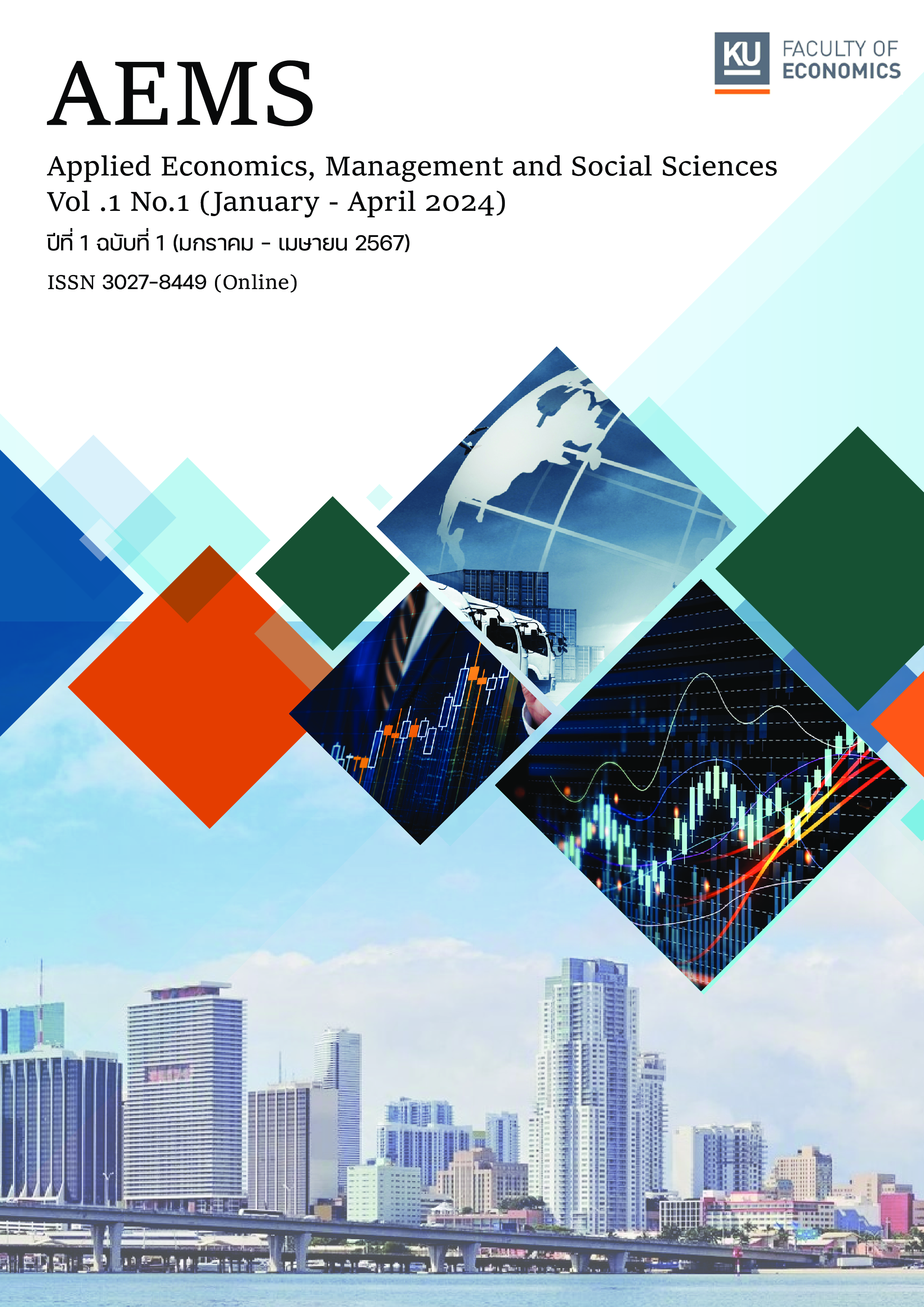Outcomes and Impact Assessment of Large-Scale Research and Innovation Creation for Area-based Development and Inequality Reduction
Main Article Content
Abstract
The outcome and impact assessment of the large set of research and innovation programs TSRI: Research and Innovation for area-based development and economic disparity Reduction main objectives aimed to evaluate administration process, outputs of the research program, outcomes and impacts of the research projects. This evaluation used in this study depended solely on economic impact assessment by assuming that investment in research projects will generate outputs, outcomes, and impacts and applying the OECD theoretical framework to assess them. 50 research projects under area–based development universities funded by the Program Management Unit on Area-Based Development (PMU A) in the fiscal year of 2020 were assessed. Project reports and project information published in various media are used for this study together with surveying the area and interviewing stakeholders of 8 case study projects. The data were analyzed inductively to interpret and draw conclusions. By investigating the research project, the distribution of the research grant was appropriate in terms of the targeted area, number of participants, and objective coverage. The result of the OECD assessment found that all research projects achieve relevance, coherence, effectiveness, and efficiency, according to the 20–year National Strategies, clearly determined research designs, objectives, and target groups. All projects met the research requirements, although the level of achievement was quite different from one another due to the distinction of the project’s surroundings. Most projects can generate benefits to the communities more than the cost of producing them within the time limit. The results exhibited that the sustainability aspect of most research projects was not ensured, since most projects still need continuous funding to guarantee the survival of these projects especially when the projects were finished. The main recommendation for research funding arrangements is research timeframe should be over 3-4 years. The research frameworks should be linked together and can create holistic outputs with integrated project outcomes in the research target areas.
Article Details
References
กัมปนาท วิจิตรศรีกมล. (2564). การประเมินผลกระทบจากงานวิจัยและพัฒนา: หลักการเบื้องต้นและแนวปฏิบัติ. (พิมพ์ครั้งที่ 2). กรุงเทพฯ: สถาบันคลังสมองของชาติ.
ณัฐวุฒิ อัศวโกวิทวงศ์. (2550). การมีส่วนร่วมของชุมชนในการออกแบบที่อยู่อาศัย: ประสบการณ์จากชุมชนผู้มีรายได้น้อยริมคลองใน. วารสารวิชาการคณะสถาปัตยกรรมศาสตร์ สถาบันเทคโนโลยีพระจอมเกล้าเจ้าคุณทหารลาดกระบัง, 7(1), 64-79.
มูลนิธิสถาบันวิจัยเพื่อการพัฒนาประเทศไทย. (2555)a. โการประเมินผลการวิจัยของประเทศ. (รายงานผลการวิจัย). กรุงเทพฯ: สำนักงานคณะกรรมการวิจัยแห่งชาติ.
มูลนิธิสถาบันวิจัยเพื่อการพัฒนาประเทศไทย. (2555)b. การประเมินผลการวิจัยและพัฒนาของประเทศประจำปี 2554 (รายงานผลการวิจัย). กรุงเทพฯ: สำนักงานคณะกรรมการวิจัยแห่งชาติ.
เยาวเรศ ทับพันธุ์. (2543). การประเมินโครงการตามแนวทางเศรษฐศาสตร์. (พิมพ์ครั้งที่2). กรุงเทพฯ: สำนักพิมพ์มหาวิทยาลัยธรรมศาสตร์.
ระพีพัฒน์ ศรีมาลา, พรสุข หุ่นนิรันดร์ และทรงพล ต่อนี. (2559). การจัดการสุขภาพชุมชนแบบมีส่วนร่วม:กรณีศึกษาชุมชนแห่งหนึ่งในจังหวัดฉะเชิงเทรา. วารสารวิจัยและพัฒนา วไลยอลงกรณ์ ในพระบรมราชูปถัมภ์ สาขามนุษยศาสตร์และสังคมศาสตร์, 11(3), 159-168.
สมพร อิศวิลานนท์ และสุวรรณา ประณีตวตกุล. (2547). การประเมินผลกระทบจากงานวิจัยทางวิทยาศาสตร์. กรุงเทพฯ: ศูนย์วิจัยเศรษฐศาสตร์ประยุกต์ มหาวิทยาลัยเกษตรศาสตร์.
สำนักงานคณะกรรมการส่งเสริมวิทยาศาสตร์ วิจัยและนวัตกรรม (สกสว.). (2565). กรอบและขอบเขตการประเมินแผนงานวิจัยและนวัตกรรมขนาดใหญ่ที่มีมูลค่า 100 ล้านบาทขึ้นไป. กรุงเทพฯ: สำนักงานคณะกรรมการส่งเสริมวิทยาศาสตร์ วิจัยและนวัตกรรม.
สำนักงานคณะกรรมการส่งเสริมวิทยาศาสตร์ วิจัยและนวัตกรรม (สกสว.). (2564). ประชุมวิชาการระดับชาติ หนุนแวดวงวิจัย ประเมินผลตอบแทนทางเศรษฐกิจและสังคมของผลงานวิจัยโดยใช้เทคนิค SROI. ค้นจาก https://tsri.or.th/ th/news/ content/640/Financial-Proxy-and-Best-Practice-of-SROI
สำนักงานพัฒนาวิทยาศาสตร์และเทคโนโลยี. (2550). การประเมินความคุ้มค่าของการวิจัยในภาพรวมของประเทศ. กรุงเทพฯ: สำนักงานคณะกรรมการวิจัยแห่งชาติ.
สุวรรณา ประณีตวตกุล. (2552). การจัดการและประเมินผลการวิจัย. เอกสารคำสอนรายวิชา EC01119592 ภาควิชา เศรษฐศาสตร์เกษตรและทรัพยากร คณะเศรษฐศาสตร์ มหาวิทยาลัยเกษตรศาสตร์.
อมรพันธุ์ เปล่งงูเหลือม. (2556). ปัจจัยที่เอื้อต่อความสาเร็จในการพัฒนาชุมชนตามแนวทางปรัชญาเศรษฐกิจพอเพียง ของเทศบาลตาบลบ้านเดื่อ อาเภอเกษตรสมบูรณ์ จังหวัดชัยภูมิ. วารสารนวัตกรรมและการจัดการ มหาวิทยาลัยราชภัฎสวนสุนันทา, 1, 74-85.
ACIAR. (2008). Guidelines for assessing the impacts of ACIAR’s research activities. ACIAR Impact Assessment Series, 58.
Alston, J. M., Norton, G. W., & Pardey, P. G. (1995). Science under scarcity: Principles and practice for agricultural research evaluation and priority setting. International Service for National Agricultural Research.
Arnold, E. & Balazs, K. (1998). Methods in the evaluation of publicly funded basic research. UK: Technopolis.
Correct citation: Walker T., Maredia M., Kelley T., La Rovere R., Templeton D., Thiele G., and Douthwaite B. 2008. Strategic Guidance for Ex Post Impact Assessment of Agricultural Research. Report prepared for the Standing Panel on Impact Assessment, CGIAR Science Council. Science Council Secretariat: Rome, Italy.
Haacker, M., Hallett, T. B., & Atun, R. (2020). On discount rates for economic evaluations in global health. Health Policy and Planning, 35(1), 107-114.
Khandker, S. R., Koolwal, G. B., & Samad, H. A. (2009). Handbook on impact evaluation: quantitative methods and practices. World Bank Publications.
Kilpatrick Jr, H. E. (1998). Some useful methods for measuring the benefits of social science research. (Research report No. 21). Washington, DC: International Food Policy Research Institute.
OECD, (2019). Better Criteria for Better Evaluation Revised Evaluation Criteria Definitions and Principles for Use. OECD/ DAC Network on Development Evaluation. Organization for Economic Co-operation and Development, 13.
Templeton, D., & Villano, L. (2006, July). Concepts and tools for agricultural research evaluation and impact assessment. International Rice Research Institute (IRRI) Workshop Report, 24.

